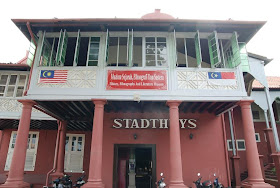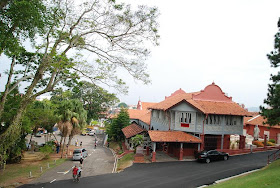It is said that the Stadthuys is probably the oldest remaining Dutch colonial building left in Southeast Asia. However, the history of the Stadthuys remains somewhat of a mystery. Records of its construction have now either been lost in time or perhaps still buried in some forgotten archive, yet to be discovered. All that is known about the age of the building is that it was built shortly after Malacca was captured by the Dutch in 1641.
Malacca came under Portuguese control by capturing the famous Malay trade emporium and ousting its sultan in 1511.


During the Dutch rule of Malacca, the Stadthuys, like all the other Dutch administration buildings in Southeast Asia, was painted white. By way of the Anglo-Dutch treaty of 1824, Malacca was given up by the Dutch and the town became a British colony. In 1911, the British painted the Stadthuys and the Christ Church a salmon red.
The actual reasons as to why these buildings were painted red by the British is now lost in time but legends and theories are abundant.
(1) One opinion was that the buildings were painted red to copy the colour of red brick stone houses in Holland. Apparently, the Dutch painted the buildings red to remind them of their homeland. However, this theory is flawed because it was the British, and not the Dutch, who painted the buildings red.
(2) Another theory was that the British wanted to differentiate British built houses from the old Dutch houses. Therefore, the British painted the old Dutch buildings red. However, there were other old Dutch buildings in Malacca that were not painted red by the British.
(3) Most amusingly, it was also suggested that the red discharge from chewing sireh (betel) was constantly spat onto the white walls of the buildings by the locals in venting their hatred and contempt for the Dutch. Later, the British simply decided to cover it up with red paint. A witty tale probably perpetuated by anti-Dutch propaganda and contrived by nationalistic British colonials.
(4) A more plausible reason given was maybe due to the lack of maintenance, the red laterite stone used to build the Stadthuys showed through the whitewashed plastering. Also, perhaps heavy tropical rain often splashed the red soil up the white walls. So, the British decided to paint it all red to save maintenance costs.





















No comments:
Post a Comment